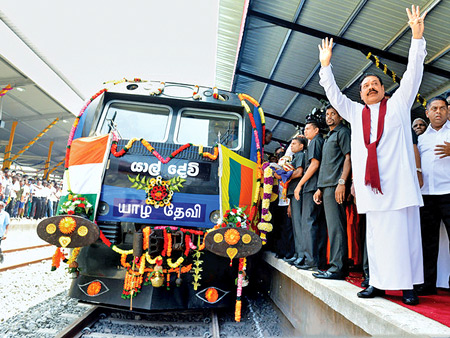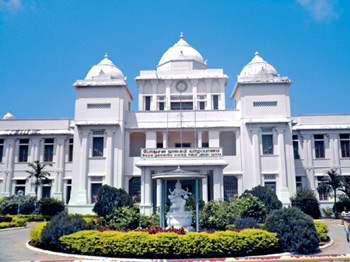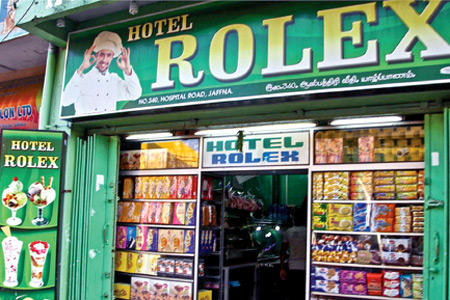Introducing Jaffna: Sri Lanka's rising star
by Ian Lloyd Neubauer
Earlier this year, hundreds of enthusiastic Sri Lankans joined Sri
Lankan President Mahinda Rajapaksa at Jaffna Station to witness the
arrival of the Queen of Jaffna for the first time in 24 years.
 |
|
New beginning for Jaffna…
As the 'Queen of Jaffna' returns to service .. it's the only
train service connecting the North with Sri Lanka's capital. |
The long suspended "Queen" train service connects the capital Colombo
to the city of Jaffna, a former war zone on the island's far north.
The rail track was built by the British in 1905 and shut down in 1990
by Tamil rebels, who spent a quarter of a century fighting for a
separate homeland in the north.
Since the end of terrorism, Sri Lanka has been pegged by some as
Asia's next big travel destination.
A growing number of tourists are visiting the palm-fringed beach
resorts of Tangala and Bentota, the lush tea estates in the southern
highlands and the ancient cities of Kandy and Anuradhapura in the
central plains.
However, Jaffna, once a prosperous port city accessible only by a
long and tiring drive, had kept all but the most intrepid travelers
away.
The return of Queen of Jaffna train service promises a positive new
beginning in the postwar era.
"For nearly 30 years, we could not even think of going there," says P
Roshanlal Perera, manager of the Tea Factory, one of the most notable
hotels in the country's southern highlands.
"But now I am waiting for the opportunity to return. I'm very keen to
see how the reconstruction efforts are shaping up."
Throughout most of the medieval era, Jaffna was either ruled or
heavily influenced by the kingdoms of southern India, which lies less
than 50 kilometers west across the Palk Strait.
So it's not surprising to discover Indian and Hindu culture is
omnipresent in Jaffna.At the city's bustling daffodil-coloured central
marketplace, Hindi music screams from DVD shops and public loudspeakers
affixed to electricity poles.
 |
| Jaffna's
Public Library is nevertheless a city landmark. |
 |
| Hotel Rolex is
neither a hotel nor sponsored by the luxury watch. It's a
restaurant serving authentic Northern Sri Lankan food. |
Restaurants like Hotel Rolex (not a hotel) add generous doses of
chili to their chicken curry and coconut sambal paste, while emaciated
holy cows stroll down the street -- oblivious to the congestion they
cause.
But nothing says India more than the candy-coloured, richly decorated
Dravidian-style Hindu temples that soar over Jaffna's haphazard
buildings and homes.
Non-Hindus are welcome as long as they adhere to the rules: shoes
must be removed, women must cover their legs, men must remove their
shirts and photography isn't allowed inside the temples.
The best time to visit Hindu Temples like Nallur Kandaswamy is 4
p.m., when daily ceremonies take place.
Like a scene from a Bollywood movie, these rituals are a total
assault on the senses.
Draped in orange robes, Hindu priests belt intoxicating melodies
using trumpets, symbols and bongos while devotees chant in unison and
the sweet blue smoke of burning incense sticks wafts through the air.
Jaffna New Market Complex, between Hospital Street and Powerhouse
Road; closed Sundays
Hotel Rolex Restaurant, 340 Hospital St., Jaffna; +94 (0)77 907 9888;
7 a.m.-10 p.m., meals from 240 rupees ($2) Nallur Kandaswamy Temple,
corner of Jaffna-Point Pedro and Temple Roads, Jaffna; ceremonies held
daily 4-5 p.m. Set on Sri Lanka's northern tip and surrounded by
brackish lakes and lagoons, Jaffna is a city not by the sea but "of the
sea."
Its strategic position proved irresistible to European navigators who
ruled Sri Lanka from the 17th century and built a succession of
sophisticated forts.
The current fort -- a star-shaped structure with corner bastions and
a moat -- was built by the Dutch East India Company in 1792.
It was one of the most technologically advanced forts in the days of
limited range cannon-powered naval warfare.
It had been perfectly preserved until 1980, when it was destroyed in
the civil war. But following an extensive rebuild co-sponsored by the
Netherlands, Jaffna Fort reopened to the public in October 2013.
Complete with spiral staircases, labyrinth-like chambers and a small
museum with colonial-era photographs, it's the perfect place for a walk
late in the afternoon when the burning heat of the day begins to calm
down. The reconstructed Jaffna Library stands as another symbol of
Jaffna's rebirth.
It was burned to the ground in 1981 by pro-government paramilitary
forces, resulting in the destruction of nearly 100,000 books,
centuries-old newspapers and palm-leaf manuscripts of incalculable
historical value.
The library's destruction is said to have fueled the Tamil
independence movement, while its reconstruction is likewise seen as a
symbol of a thriving postwar Sri Lanka.
The gleaming white art deco building is fronted by a statue of the
Saraaswati, the Hindu goddess of learning.
Entry into the library is restricted to students.
"You can visibly see the scars left from the past conflict, but you
also feel the positive vibes that its moving on in the right direction,"
says Harpo Gooneratne, a restaurateur from Colombo looking to open a
hotel school and a coffee house in Jaffna.
"It's one area of Sri Lanka not discovered by many, but I think the
tourism boom will strike here next."
Jaffna Fort, corner of Point Pedro and Beach Roads, Jaffna Jaffna
Public Library, Jaffna-Kankesanturai Road, Jaffna; daily 9 a.m.-7 p.m.
West of the city, the Jaffna archipelago consists of 10 low-lying
islands edged by beaches and mangrove forests.
Cast aside preconceptions of tropical hideaways, for the islands are
suffocatingly dry, laced with salt flats and ranked among the wildest
and remotest in Sri Lanka.
Yet there's beauty in the isolation -- a vast, flat world of blue and
white colors that shimmers like a mirage under the sun.
And four of these islands are now linked by causeways that make them
easy to explore. Riding in a car or bus over the causeways that hover
over lagoons and tidal flats is surreal.
Only the hardiest of birdlife -- cormorants, kites, fish eagles --
and equally hardy people are able to survive here, eking out a living
from fishing or coconut farming.
Courtesy: CNN |

